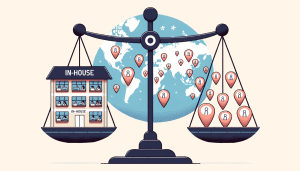Estimated reading time: 10 minutes
Key Takeaways
- Employee productivity apps shift teams from ad-hoc habits to structured, transparent workflows.
- Integrated tools enhance focus, reduce friction, and align work with strategic goals across hybrid, remote, and office setups.
- Prioritise interoperability, security, and measurable pilots when selecting your stack.
- Adoption accelerates with training, clear communication of value, and champion-led rollouts.
- Emerging trends include AI assistance, unified dashboards, flexible licensing, and ethical analytics.
Table of Contents
Employee productivity software has evolved from optional to indispensable. Modern organisations rely on digital tools that sharpen focus, remove friction, and keep everyone aligned with strategic goals. Whether staff share an office, log in from home, or split their week between both, the right mix of applications ensures work flows smoothly and results arrive on schedule. This guide outlines the core categories, explains the value of each, and offers practical insight so you can select tools that match your culture, structure, and ambitions.
Why Employee Productivity Apps Matter
Employee productivity apps exist to streamline collaboration, information flow, and decision-making. They underpin day-to-day activity by replacing ad-hoc methods with structured, transparent processes. Teams gain a clear picture of priorities, operations lose duplication, and leadership receives reliable data for planning.
A workforce scattered across locations faces time-zone gaps, varied home office setups, and competing commitments. Well-chosen productivity platforms counter those challenges. Studies reveal higher satisfaction, lower turnover, and shorter project cycles when organisations adopt integrated solutions. Tasks move faster, communication improves, and performance metrics become objective rather than anecdotal.
Key Features Worth Examining
“Valid data replaces guesswork, enabling evidence-based improvements that continue long after launch week.”
Employee Productivity Tracker
An employee productivity tracker captures output, timelines, and workload in real time. Dashboards surface patterns that help managers spot overload, celebrate high achievement, and reallocate resources before problems grow. Valid data replaces guesswork, enabling evidence-based improvements that continue long after launch week.
Time Tracking App
Precise time records protect billable revenue, expose hidden drains on capacity, and encourage realistic scheduling. By itemising hours against projects and clients, a time tracker shows exactly where staff effort lands. This transparency deters scope creep, supports fair invoicing, and sharpens future estimates.
Task Management Software
Task management platforms break large objectives into bite-sized actions with owners, due dates, and priority tags. Clarity reduces cognitive load and keeps the entire team focused on the next logical step. Because every item lives in one place, duplicate work disappears and handovers become seamless. Managers gain oversight without micromanagement, while staff enjoy autonomy within a structured frame.
Workflow Optimisation Tools
Workflow tools map each step of a business process, then highlight loops, delays, and unnecessary approval gates. Once visualised, inefficiencies become obvious. Refining or automating those weak points cuts wasted effort, shortens cycle times, and guarantees consistent results no matter who performs the work. Built-in analytics keep the process under review so it evolves with organisational needs.
Employee Performance Monitoring
Continuous performance monitoring blends quantitative metrics with qualitative feedback. Instead of waiting for an annual appraisal, managers and employees address issues or recognise excellence while projects are still active. This timely dialogue encourages growth, aligns expectations, and ensures quality remains as important as quantity.
Productivity Analysis
Raw numbers carry limited meaning until translated into context. Productivity analysis software aggregates data across tools, then reveals trends, correlations, and outliers. Leadership can see how a change in staffing, methodology, or workload affects delivery speed and quality. The insight supports proactive decisions that head off bottlenecks before they impair client commitments.
Project Tracking Apps
Complex initiatives involve multiple milestones, dependencies, and specialists. Project tracking platforms create a single source of truth, recording scope, timeline, budget, and risk factors. Automatic alerts flag any slip the moment it begins, giving the team time to adapt. Historical records from finished projects refine future planning and pricing.
Team Collaboration Apps
Chats, threaded discussions, video calls, and shared documents all sit in one secure workspace, reducing email overload and misplaced files. Clear channels for quick questions and deeper debates maintain momentum, while searchable archives preserve decisions for reference. Integrations with task systems turn conversation into action without extra data entry.
Productivity Reporting Software
Stakeholders from interns to executives require information tailored to their role. Reporting tools convert metrics into graphs, heat maps, and narrative summaries that suit each audience. Consistent report schedules create natural checkpoints, encouraging continual alignment with targets and swift responses when trends shift.
Employee Time Management
Calendars, focus timers, and smart schedulers help staff defend deep-work blocks while remaining available for collaboration. Visibility into colleagues’ availability prevents meeting clashes and preserves uninterrupted concentration. By breaking days into purposeful segments, time management tools support sustainable productivity rather than prolonged, unfocused hours.
Workflow Automation Apps
Rule-based automation removes repetitive data entry, approval routing, and notification tasks. Human attention shifts to analysis, creativity, and relationship-building, areas where machine execution falls short. Consistency rises, errors decline, and compliance records stay intact. Automation also scales processes without linear increases in headcount.
Employee Engagement Apps
Recognition walls, pulse surveys, and learning portals keep morale strong and guidance timely. When achievements are visible and feedback loops are short, employees feel valued and understand how their work contributes to wider objectives. Engagement tools therefore sustain the human element vital to any productivity strategy.
Guidelines for Selection
- Identify Pain Points – Begin by mapping current workflows and locating friction. A clear problem statement ensures you avoid duplicating existing capabilities or purchasing features that remain unused.
- Align With Culture – Some teams thrive on transparency, while others prefer status updates at defined intervals. Choose tools that fit established norms or plan a structured change programme that gives staff time to adapt.
- Insist on Interoperability – Silos undo much of the benefit promised by productivity software. Confirm that prospective apps integrate through APIs or native connectors with your calendar, file storage, and communication stack.
- Trial With Measurable Targets – Set baseline metrics before pilot deployment, then review after a fixed period. Look at cycle time, error count, satisfaction scores, or revenue capture. Data will justify expansion or spark iteration.
- Support and Training – Even intuitive software demands onboarding. Provide tutorials, Q&A sessions, and reference materials. Early wins boost adoption and guard against reversion to manual habits.
- Review Security and Compliance – Productivity hinges on trust. Ensure vendors hold appropriate certifications, encrypt data at rest and in transit, and offer audit trails that satisfy regulatory obligations.
Implementation Tips
Start Small
Launching every feature at once overwhelms users. Activate core functions, gather feedback, then layer additional capabilities.
Nominate Champions
Select enthusiastic staff members to test new workflows, answer peer questions, and relay suggestions back to the project team.
Communicate Value
Explain not just how the software works but why it matters. Link benefits to specific pain points such as late invoicing or missed deadlines.
Monitor Performance Continuously
Dashboards reveal whether the tool raises efficiency or whether further configuration is required. Adjust promptly.
Celebrate Milestones
Highlight quantifiable gains, such as a 15 percent reduction in approval cycles or a three-hour weekly saving per analyst. Publicising results sustains momentum.
Common Pitfalls and How to Avoid Them
- Over-customisation – Excessive tweaking can make upgrades painful and training complex. Use default settings unless a clear case exists for change.
- Ignoring User Feedback – Staff who spend hours in the platform notice practical issues early. A feedback loop prevents disillusionment and rescues adoption.
- Underestimating Data Clean-up – Historical records may be inconsistent. Plan time to standardise past information before migration, otherwise reports will mislead.
- Neglecting Mobile Experience – Remote and field workers rely on phones or tablets. Verify that essential tasks function smoothly on smaller screens.
Future Trends
- Artificial Intelligence Assistance – Context-aware suggestions, automatic summarisation, and predictive scheduling will become standard, freeing people from routine micro-decisions.
- Unified Dashboards – As integration deepens, single panes of glass will combine tasks, messages, and analytics across multiple applications, reducing context switching.
- Flexibility in Licensing – Subscription models are moving towards granular, pay-for-what-you-use tiers, allowing organisations to scale licences precisely with headcount fluctuations.
- Ethical Analytics – Expect greater scrutiny regarding how employee data is captured and used. Solutions that offer transparency and opt-in controls will outpace those that do not.
Conclusion
Productivity apps succeed when they address a specific barrier, integrate smoothly with existing systems, and earn buy-in through clear evidence of benefit. By following the selection guidelines above, providing robust support, and measuring outcomes consistently, organisations can release staff from avoidable hassle and concentrate collective effort on value-creating work. The result is faster delivery, stronger engagement, and a competitive edge that endures.
FAQs
What are employee productivity apps?
They are digital tools that streamline collaboration, information flow, and decision-making by replacing ad-hoc methods with structured, transparent processes. The outcome is clearer priorities, less duplication, and better data for planning.
Which features should we prioritise when choosing tools?
Focus on capabilities that match your workflows: task and project tracking, time tracking, workflow optimisation, collaboration, reporting, and automation. Prioritise interoperability, security, and the analytics you need to make evidence-based improvements.
How do time tracking and project tracking differ?
Time tracking records hours against projects or clients to improve billing accuracy and scheduling, while project tracking manages scope, milestones, dependencies, budget, and risks to keep delivery on track.
How can we roll out new tools without overwhelming staff?
Start small with core functions, nominate champions, communicate the “why,” provide training and resources, monitor dashboards for early signals, and celebrate measurable wins to sustain momentum.
What metrics show productivity gains?
Cycle times, error rates, satisfaction scores, billable capture, workload balance, and on-time delivery trends. Use consistent reporting to create checkpoints and align action with targets.







